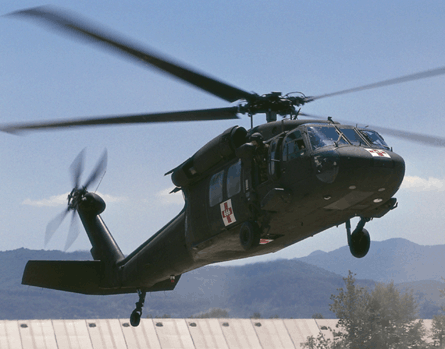The US Army is working on increasing the safety of its rotary-wing aircraft in degraded visual environments.
An army study recently concluded "the greatest threat to our aircraft was what we call degraded visual environments," says Col Anthony Potts, the army's aviation systems project manager.
A helicopter on its terminal approach might kick-up a cloud of dust and debris, known as a "brown out", which causes pilots to lose their visual reference to the Earth's surface, and could lead to a crash if the helicopter snags an object.
Potts says the army is working on a number of technological solutions to the problem--the most promising being a 94GHz millimetre wave radar system.
"There is a lot of debate about whether that is the right solution or not," Potts says. "I can tell you there are other solutions out there."
 |
|---|
Those solutions include laser-based Light Detection and Ranging (LIDAR), long-wave infrared cameras, and synthetic vision using precise geographic data-bases, among others.
"What we found was that the millimetre wave radar actually had the best capability to penetrate those heavy dust obscurants," Potts says.
The radar essentially creates synthetic imagery in front of the aircraft in real-time which alerts pilots to the presence of obstacles.
But having the right cockpit symbology also is important, Potts says. Newer versions of the Boeing AH-64D and CH-47F, for example, already have such cuing systems, and therefore do not need this type of augmentation as much as other aircraft.
The Sikorsky UH-60L, an older model Blackhawk, has the greatest need for such a pilot aid.
Part of the solution might also be adding a detailed database of the terrain to augment the system, Potts says.
Rockwell Collins was demonstrating a version of such a system on a UH-60 simulator at an Army Aviation Association of America (AAAA) forum in Nashville,Tennessee. The company says its technology is already being used on business jets and it will soon to integrating its system with radar.
Potts was seen visiting the Rockwell Collins simulator at AAAA.
Over the next five years, the army plans to spend $226 million on a solution to the degraded visual environment problem. In the next 18 to 24 months the service will write up an operational needs statement and buy five prototype 94GHz radar systems from Science and Engineering Services and Sierra Nevada Corp. If the system proves to be successful, the service has the option of buying more for limited user trials.
At the same time, the army is working on preparing a formal developmental programme which it hopes to start in the fourth quarter of 2012, Potts says.
The operational needs statement and prototypes will help inform the developmental program as will input from the army's elite special operations forces and the Defense Advanced Projects Research Agency (DARPA).
"We found a great partnership with those guys," Potts say.
The idea is to build a "backbone" architecture that can accommodate almost any sensor or a combination of sensors. "So when we get to a programme, we're not tiedto a specific material solution," Potts says.
Source: Flight International



















